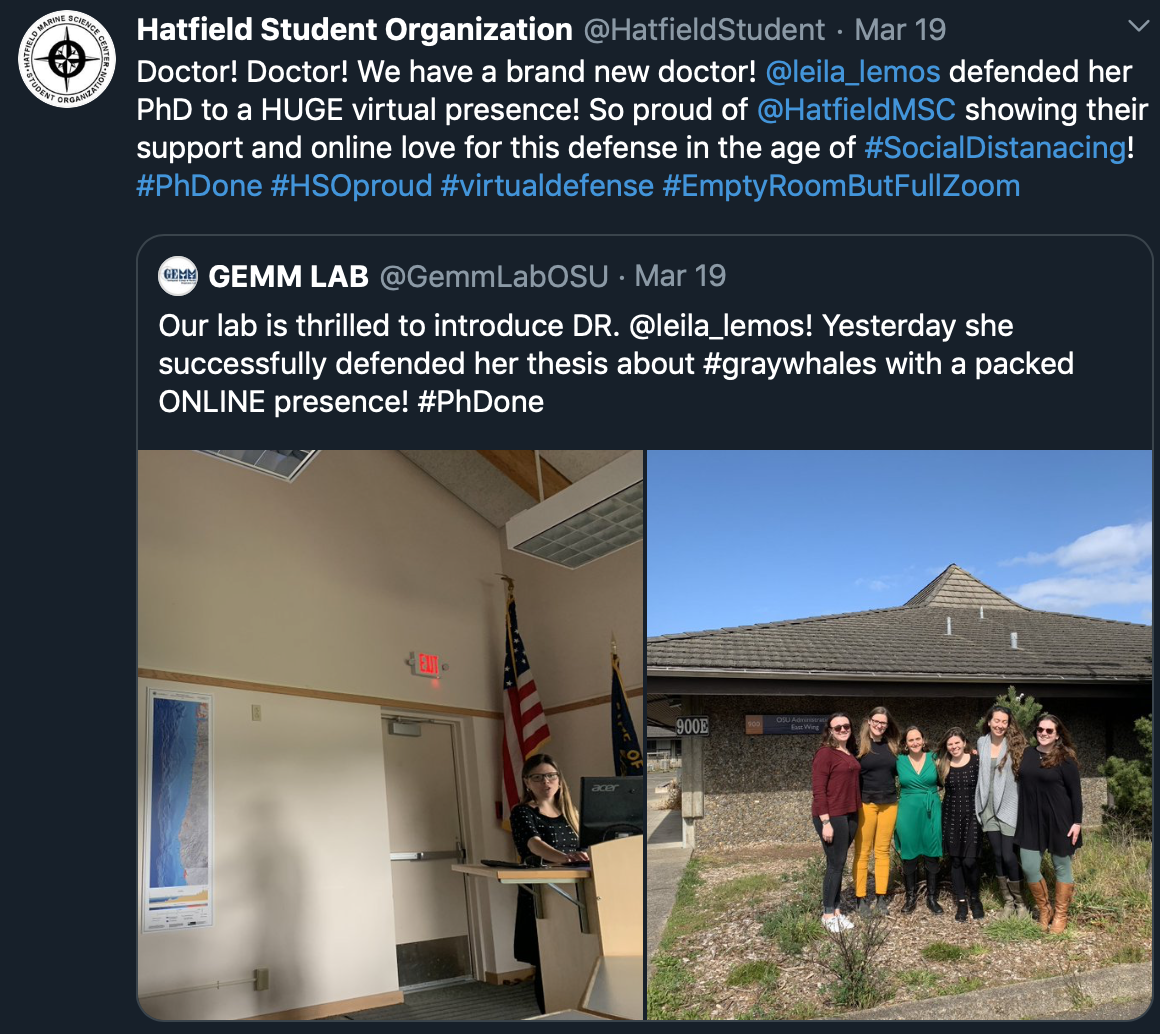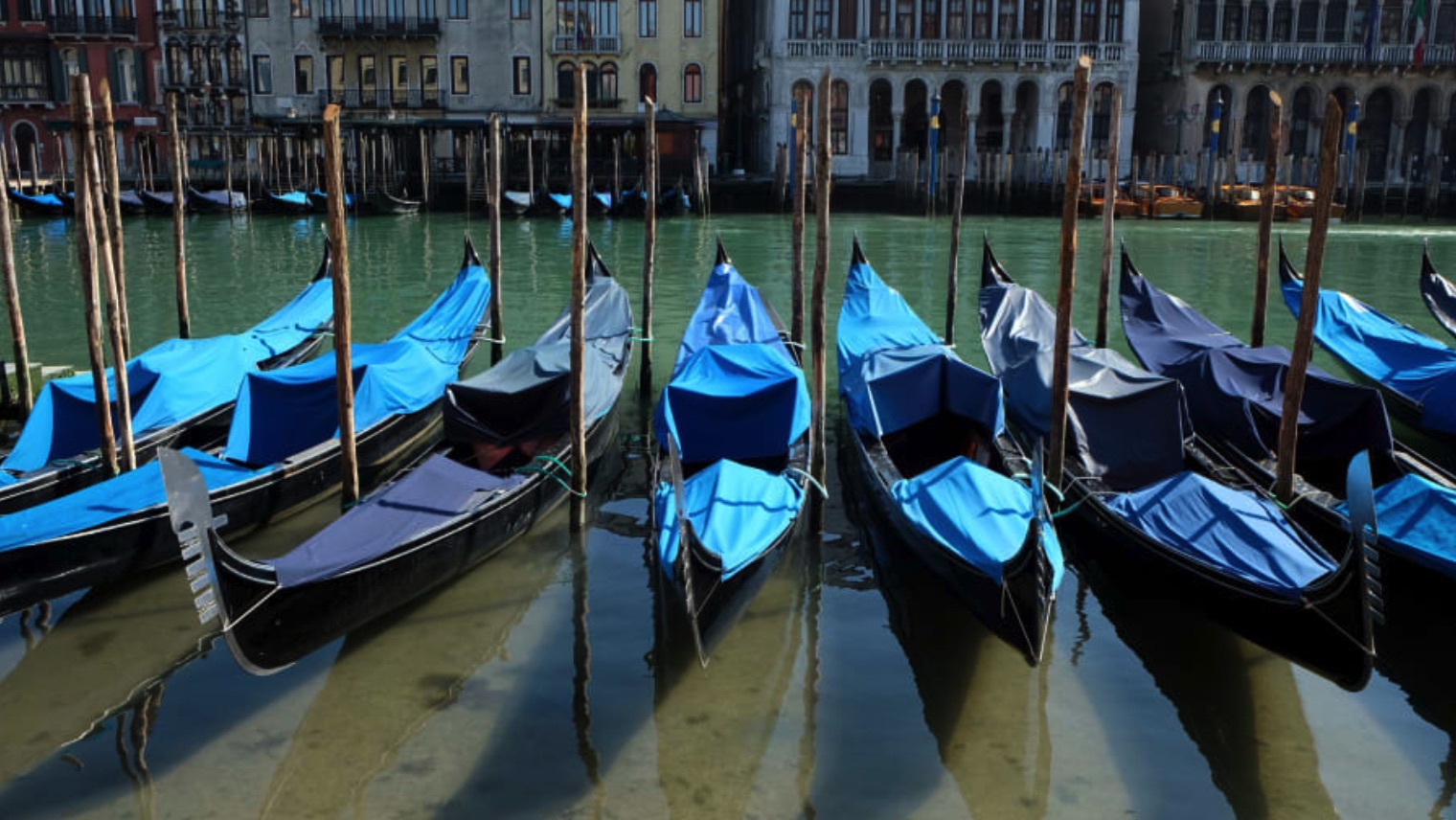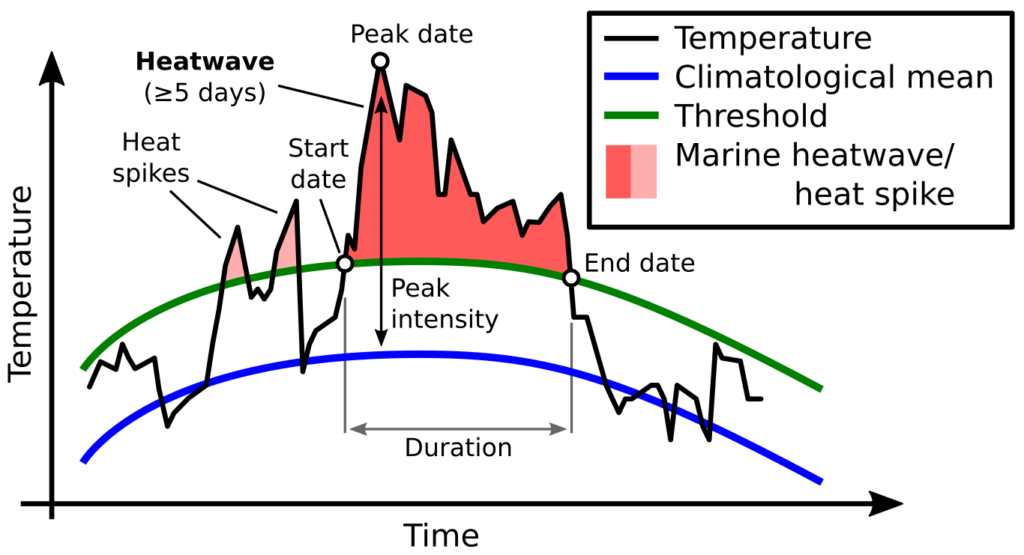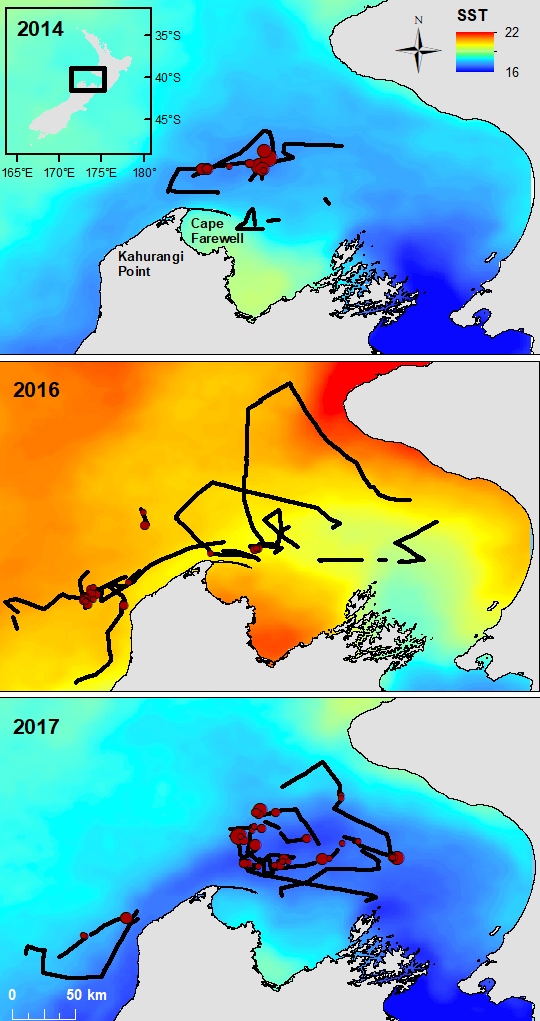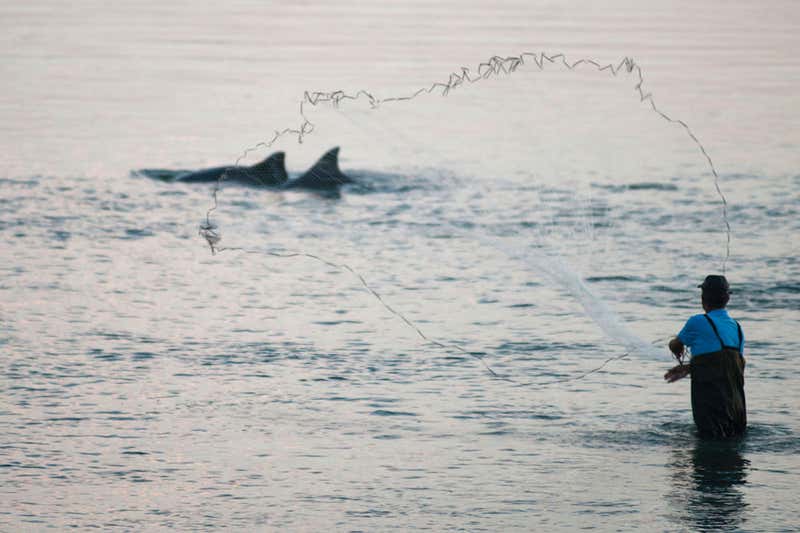By Lisa Hildebrand, MSc student, OSU Department of Fisheries & Wildlife, Marine Mammal Institute, Geospatial Ecology of Marine Megafauna Lab
I want to start my post this week with a disclaimer – I am not a virologist or an epidemiologist. My knowledge and understanding on what a virus is, how it changes and spreads, and predicting its trajectory, is very limited (though it has definitely improved in recent weeks). Nevertheless, I did not want that to stop me from shifting my focus and time currently spent reading about a certain virus in humans, to thinking about viruses in marine mammals. So, after several hours of reading papers and reports, I believe I have a good enough grasp on viruses in marine mammals to write a blog post on this topic.
To answer the question in my title – yes, marine mammals can get coronavirus! Coronaviruses have been detected in several marine mammals – mostly in captive ones (harbor seal, beluga whale, Indo-Pacific bottlenose dolphin), but it was also detected in a wild harbor seal1. It is at this point where I am going to step back from marine mammals for a moment and give a very short ‘lesson’ on viruses.
Viruses are microscopic infectious agents that replicate inside living cells of organisms. They have the ability to infect all forms of life – anything from bacteria to plants to animals to humans. Nothing is excluded. Viruses are classified similarly to how living organisms are classified. Try to think back to middle school science when your teacher used mnemonic devices like, “Kids prefer candy over fancy green salad” or “Kings play chess on fine glass surfaces”, to get you to remember the Kingdom-Phylum-Class-Order-Family-Genus-Species classification. Well, viruses have almost the same classification tree. The only difference is that instead of Kingdom at the top, viruses have a Realm. As of 2019, the International Committee on Taxonomy of Viruses (ICTV) has defined 5,560 species of viruses in over 1,000 genera and 150 families. Different species of virus are classified based on their genomic material and key elements of structure and replication. That is as far as I am going to go with virus background – back to marine mammals!

So, yes, coronaviruses have been detected in marine mammals before. But, no, they were not the same species of coronavirus that is currently spreading across the globe in humans. Coronavirus, or Coronaviridae, is a family of viruses that contains around 40 species. However, coronavirus is not the family that has plagued marine mammals the most since research on marine mammal diseases began. The infectious disease that I have found to be the most common and recurring in marine mammals is morbillivirus and I will therefore focus on that virus for the rest of this post.
Morbillivirus is a genus of viruses in the family Paramyxoviridae and hosts of this genus include humans, dogs, cats, cattle, seals, and cetaceans. There are seven described species of morbillivirus, three of which have been detected in marine mammals, namely canine distemper virus (CDV), cetacean morbillivirus (CeMV), and phocine distemper virus (PDV). The earliest, traceable case of morbillivirus in a marine mammal occurred in 1982 in bottlenose dolphins in the Indian and Banana Rivers in Florida2. This case was followed by hundreds of others in subsequent years all along the Atlantic U.S. coast and resulted in the first Unusual Mortality Event (UME; 1987-1988) that was concluded to have been caused by morbillivirus (Table 1).
Table 1. Unusual Mortality Events (UMEs) of marine mammals in the U.S. where the cause was determined to be or is suspected to be morbillivirus. Data obtained from NOAA Fisheries.

Interestingly, at the same time as this 1980s morbillivirus in the US, the first documented marine mammal morbillivirus epidemic occurred in Europe in the North Sea. This outbreak led to the death of more than 23,000 harbor seals, which accounted for roughly 60% of all North Sea harbor seals at the time3. The virus that was isolated from the stranded seals in the North Sea was similar to CDV but not exactly the same. Resultantly, it was described as a new species of morbillivirus and it was therefore the first outbreak of PDV. Another interesting thing about this case in Europe is that while the infection originated at the Danish island of Anholt, new centers of infection appeared quite far from this first epicenter within a relatively short amount of time (~3-4 weeks) from the initial outbreak, some as far as the Irish Sea (~2,000 km away; Figure 1). Harbor seals typically have a limited home range and do not travel such distances, leading scientists to speculate that grey seals may have been a carrier of the virus and transported it from Anholt to haul-out sites in the Irish Sea. Mixed species haul-out sites of harbor and grey seals are very common across the North Sea and is the most logical explanation for the rapid spread of the virus across such distances.

Harbor seals seem to be the most susceptible to PDV based on all documented cases of PDV outbreaks, however the reason for this pattern remains unknown1. While CDV has only been detected in Baikal and Caspian seals, CeMV has occurred in a larger number of cetaceans including harbor porpoises, striped, bottlenose, Guiana and Fraser’s dolphins, pilot whales, and a minke whale. This list is not extensive as morbillivirus has been found in 23 of the 90 cetacean species. In fact, it has been suggested that CeMV should be divided into more than one species as the morbilliviruses detected in the Northern Hemisphere show significant divergence from those found in the Southern Hemisphere.
Transmission is believed to mostly occur horizontally, meaning that the morbillivirus is passed from one individual to another. This transfer happens when one individual inhales the aerosolized virus breathed out by an infected individual. This is likely the reason why odontocete and pinniped groups are most affected due to their social group behavior and/or high density of individuals within groups4. However, vertical transmission has also been suggested as a possible transmission route as morbillivirus antigens have been detected in the mammary glands of bottlenose dolphins along the U.S. Atlantic Coast5 and striped dolphins in the Mediterranean Sea affected by CeMV6. Thus, it has been postulated that CeMV infected females could transmit the infection to their fetuses and neonates in utero, as well as to their calves during lactation.

Morbilliviruses mostly affect the respiratory and neurologic systems in marine mammals, wherein affected individuals may display ocular and naval discharge, erratic swimming, respiratory distress, raised body temperature, and/or cachexia (weakness and wasting away of the body due to severe illness). However, most diagnoses occur post-mortem. Some individuals may survive the initial acute infection of morbillivirus, yet the general weakening of the immune system will make individuals more susceptible to other infections, diseases, and disturbance events7.
It is impossible to know whether marine mammals take precautions when a virus has taken grip of a group or population, or if marine mammals even have an awareness of such things occurring. There obviously is no such thing as an emergency room or a doctor in the lives of marine mammals, but do individuals perhaps demonstrate social distancing by increasing the space between each other when traveling in groups? Do groups decrease their traveling distances or foraging ranges to isolate themselves in a smaller area? Are sick individuals ‘quarantined’ by being forced out of a group? These are just some of the questions I have been asking myself while working from home (day 16 for me now). I hope you are all staying safe and healthy and have enjoyed distracting yourselves from thinking about one virus to learn about another in a different kind of mammal.
Literature cited
1 Bossart, G. D., and P. J. Duignan. 2018. Emerging viruses in marine mammals. CAB Reviews 13(52): doi:10.1079/PAVSNNR201913052.
2 Duignan, P. J., C. House, D. K. Odell, R. S. Wells, L. J. Hansen, M. T. Walsh, D. J. St. Aubin, B. K. Rima, and J. R. Geraci. 1996. Morbillivirus infection in bottlenose dolphins: evidence for recurrent epizootics in the western Atlantic and Gulf of Mexico. Marine Mammal Science 12(4):499-515.
3 Härkönen, T., R. Dietz, P. Reijnders, J. Teilmann, K. Harding, A. Hall, S. Brasseur, U. Siebert, S. J. Goodman, P. D. Jepson, T. D. Rasmussen, and P. Thompson. 2006. A review of the 1988 and 2002 phocine distemper virus epidemics in European harbor seals. Diseases of Aquatic Organisms 68:115-130.
4 Van Bressem, M-F., P. J. Duignan, A. Banyard, M. Barbieri, K. M. Colegrove, S. De Guise, G. Di Guardo, A. Dobson, M. Domingo, D. Fauquier, A. Fernandez, T. Goldstein, B. Grenfell, K. R. Groch, F. Gulland, B. A. Jensen, P. D. Jepson, A. Hall, T. Kuiken, S. Mazzariol, S. E. Morris, O. Nielsen, J. A. Raga, T. K. Rowles, J. Saliki, E. Sierra, N. Stephens, B. Stone, I. Tomo, J. Wang, T. Waltzek, and J. F. X. Wellehan. 2014. Cetacean morbillivirus: current knowledge and future directions. Viruses 6(12):5145-5181.
5 Schulman, F. Y., T. P. Lipscomb, D. Moffett, A. E. Krafft, J. H. Lichy, M. M. Tsai, J. K. Taubenberger, and S. Kennedy. 1997. Histologic, immunohistochemical, and polymerase chain reaction studies of bottlenose dolphins from the 1987-1988 United States Atlantic coast epizootic. Veterinary Pathology 34(4):288-295.
6 Domingo, M., J. Visa, M. Pumarola, A. J. Marco, L. Ferrer, R. Rabanal, and S. Kennedy. 1992. Pathologic and immunocytochemical studies of morbillivirus infection in striped dolphins (Stenella coeruleoalba). Veterinary Pathology 29(1):1-10.
7 Wellehan, J., and G. Cortes-Hinojosa. 2019. Marine Mammal Viruses. Fowler’s Zoo and Wild Animal Medicine Current Therapy 9:597-602.
